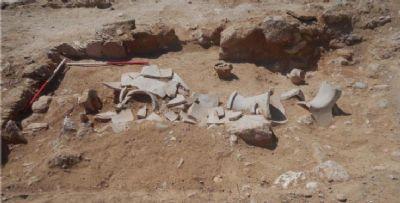Source - http://famagusta-gazette.com/important-archaeological-findings-discovered-at-the-late-cypriot-harbour-ci-p41166-69.htm
 Important archaeological findings have been discovered during the excavations at the Late Cypriot harbour city of Hala Sultan Tekke that carried out by a Swedish team in May-June 2017.
Important archaeological findings have been discovered during the excavations at the Late Cypriot harbour city of Hala Sultan Tekke that carried out by a Swedish team in May-June 2017.
According to the Department of Antiquities of the Ministry of Transport, Communications and Works, initially, the excavations were guided by the results of the georadar survey which indicated stone structures that appeared just below surface.
The deepest stone structures which were visible on the georadar map were at a depth of approximately 1m. This penetration depth corresponds to our Strata 1 and 2. These two strata (well-defined layers of occupation separated in time), both of which were violently destroyed, are dated to the 12th century BCE. Stratum 2 dates to possibly around 1200 BCE. However, in the course of the excavations massive architectural units were discovered and exposed below the maximum penetration depth of georadar, i.e. between 1.5 and 2 m from surface
Stratum 3 yielded some of the oldest remains from settlement contexts so far at the site, along with exceptionally well-preserved and closed contexts belonging to a large building with walls whose dimensions surpass those of the later strata. The Stratum 3 building uses a markedly different building technique with large conglomerate stones, preserved up to 1-1.20 m.
One of the rooms of Stratum 3 contains four storage units constructed of vertically placed, flat, worked stones and large pieces of a pithos decorated with plastic wavy lines. These installations were likely used for the storage of food such as grain and olives. One large (almost 1 m broad) grinding stone placed in the centre of the room along with several smaller grinding stones and two small pounding stones suggest a function related to the processing of cereals or vegetables. This is further supported by the preliminary archaeobotanical results, which demonstrate barley, olives, grapes and other, as yet unspecified cereals.
Another room is a workshop, where a furnace, a large amount of slag and ore, and a pit, intentionally filled with unfired clay, was found. Two floors associated with the Stratum 3 walls were plastered by limy clay. The furnace on top of the upper floor was made of a thick layer of mudbricks. The use of this furnace for copper production is attested by the large amount of slag and copper ore together with fragments of ceramic tools and burnt debris and ash. In addition, another two locally produced ceramic handles inscribed with Cypro-Minoan signs were found in these layers which are associated with metal production.
The Mycenaean pottery collected from the layers so far associated with Stratum 3 dates to Late Helladic IIIB, viz. the 13th century. This is supported especially by the presence of Aegean imported deep and shallow bowls, both shapes so far rarely attested in reliable settlement contexts at Hala Sultan Tekke.
Parallel with the project in the settlement, excavations took place in Area A. This area, excavated since 2013, is roughly 550 m east of CQ1 and close to the mosque of Hala Sultan Tekke.